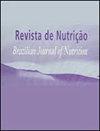相位角作为社区老年人肌肉减少症的筛查方法
IF 0.5
4区 医学
Q4 NUTRITION & DIETETICS
Revista De Nutricao-brazilian Journal of Nutrition
Pub Date : 2022-01-01
DOI:10.1590/1678-9865202235200243
引用次数: 1
摘要
【摘要】目的探讨相位角作为肌少症筛查工具的应用价值。方法我们进行了一项横断面研究,包括169名活跃的社区老年妇女。使用四极生物电阻抗确定相位角,并分别使用生物电阻抗分析、手持式测功机和步态速度测试,根据骨骼肌质量、肌肉力量和物理性能诊断肌肉减少症。进行受试者工作特征曲线分析,以研究相位角作为肌肉减少症预测因子的作用。结果骨骼肌减少症患病率为12.4%。中位相角为5.30°;老年女性肌少症患者的相位角低于无肌少症患者(p=0.006)。检测肌少症的相位角截止值为- 5.15°,曲线下面积为0.685,灵敏度81.0%,特异性60.8%,准确率63.31%。低相位角的老年妇女表现出肌肉量减少的高风险。结论相位角是老年女性肌肉减少症的有效筛查工具。本文章由计算机程序翻译,如有差异,请以英文原文为准。
Phase angle as a screening method for sarcopenia in community-dwelling older adults
ABSTRACT Objective We investigated the utility of the phase angle as a screening tool for sarcopenia. Methods We performed a cross-sectional study that included 169 active community-dwelling elderly women. The phase angle was determined using tetrapolar bioelectrical impedance, and sarcopenia was diagnosed based on skeletal muscle mass, muscle strength, and physical performance using bioelectrical impedance analysis, a handheld dynamometer, and the gait speed test, respectively. Receiver operating characteristic curve analysis was performed to investigate the role of the phase angle as a predictor of sarcopenia. Results The prevalence of sarcopenia was 12.4%. The median phase angle was 5.30°; elderly women with sarcopenia had lower phase angles than those without sarcopenia (p=0.006). The phase angle cutoff for the detection of sarcopenia was ?5.15°, with an area under the curve of 0.685, sensitivity 81.0%, specificity 60.8%, and accuracy 63.31%. Elderly women with a low phase angle show a high risk of presenting with reduced muscle mass. Conclusions The phase angle was shown to be a useful screening tool in elderly women with sarcopenia.
求助全文
通过发布文献求助,成功后即可免费获取论文全文。
去求助
来源期刊
CiteScore
1.20
自引率
12.50%
发文量
24
审稿时长
6-12 weeks
期刊介绍:
Revista de Nutrição is former Revista de Nutrição da Puccamp, founded in 1988. It is a bimonthly publication every four months and it is of responsibility of the Centro de Ciências da Vida, da Pontifícia Universidade Católica de Campinas . It publishes articles that contribute to the study of Nutrition in its many sub-areas and interfaces; and is open to contributions of the national and international scientific communities.

 求助内容:
求助内容: 应助结果提醒方式:
应助结果提醒方式:


